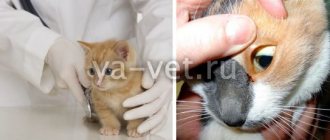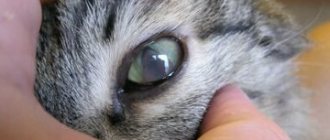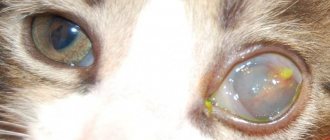15587Pavel
1
In order for a cat to always be healthy and cheerful, the breeder must carefully monitor the health of his pet. You should not think that the animal does not need full care and can be spared various problems and diseases. Particular attention should be paid to the visual organs, because they are the ones who can primarily tell you about the animal’s health status. Many people often notice a spot on a cat’s eye, but they just don’t know what to do about this symptom. But this may indicate serious pathological processes in the pet’s visual organ.
Causes of spots on the eye
A cloudy spot in a cat's eyes may occur due to damage to the cornea of the visual organ. Often a small spot or film with a milky tint appears on the surface of the eye. If a cataract appears on the surface of the visual organ, this usually indicates that the cat or dog is experiencing a decrease in visual acuity.
© shutterstock
The main reasons for the appearance of spots on the eye are the following pathological conditions::
- corneal lesions . This may be associated with certain pathological processes of an inflammatory and infectious nature, as well as injuries;
- the presence of turbidity in the intraocular fluid . This condition may result from the accumulation of large numbers of white blood cells, proteins or lipids;
- clouding of the lens during the development of cataracts;
- vitreous diseases.
Many people believe that an iris spot is a simple scar on the surface of the eye, but this is not so. The etiology of this symptom is quite wide, and sometimes it can be very serious.
Review of common causes
First of all, they look at the general condition of the pet. If a cat has a cloudy spot on its eye, then you should consider the option of viral infections, which often cause complications in the visual organs.
A dark or red color may indicate hemorrhages and broken blood vessels. This phenomenon is characteristic of intraocular pressure and serious head injuries.
Considering the risks (decrease in the quality of vision or its complete loss), when the first alarming signs appear, you should not delay a visit to the veterinarian, who should consider the following possible causes.
Corneal dystrophies
They usually appear in the first year of an animal’s life. The color of the spot on a cat’s eye depends on the nature of the substance accumulated in the cornea. These may be lipids, salts or cholesterol. In most cases, both organs of vision are affected at once.
Rarely are there any other symptoms other than spots. They do not affect the quality of vision, so veterinarians recommend simply observing them. If swelling of the eyelid or redness of the conjunctiva appears, it is recommended to see an ophthalmologist. Drug or surgical treatment may be needed.
Injury
The most common cause of dark and red spots on the eyes of cats . Even a small scratch on the cornea can cause severe discomfort for your pet and lead to clouding of the cornea. Damage most often occurs to animals visiting the street.
Climbing trees, bushes and tall grass can result in eye damage. This manifests itself in profuse lacrimation and redness of the eyelid mucosa.
If help is not provided in time, then within a few days all of the above may cause itching, which is dangerous because it will cause the animal to constantly rub its face with its paws. This almost always leads to deep scratching, aggravation of existing damage and the development of secondary infection.
Keratitis
It develops after foreign bodies, deep scratches and some infectious diseases get into the eye. There are superficial, deep and ulcerative keratitis.
It is considered a dangerous condition , as there is a risk of loss of vision in the affected organ. The owner should be alerted to sudden lacrimation, sticking of eyelashes, the appearance of a white spot on the eye, clouding of the lens and the development of photophobia. The animal may squint the affected organ or not open it at all.
The most difficult thing is if there is itching, since because of it the pet begins to rub its eyes with its paws, which can cause even more injuries to itself and aggravate existing ones. First of all, they exclude the possibility of a viral infection (most often it is the herpes virus), and then they consider the option of mechanical damage.
In Persian and Siamese cats, chronic degenerative keratitis, which occurs only in these breeds, must be excluded. In complex cases not related to herbs and viral infections, the cause may lie in helminthic infestation.
Treatment of keratitis depends on the degree of damage and the root cause (for herpes virus, Maxidin can be prescribed, for injuries, drops with the antibiotic Floxal and Tsipromed). Almost always, drops are combined with ointments (Korneregel, solcoseryl), which are placed under the eyelid. The duration of treatment can range from several weeks to a couple of months.
Corneal ulcer
Probably the most common reason for the appearance of a round spot on the eye of a cat at any age. It can form due to a scratch from claws, a prick from grass or a branch from a bush, an abnormally growing eyelash or an inversion of the eyelid.
Serious injuries (claw scratches) are almost always accompanied by profuse lacrimation and redness of the conjunctiva. If treatment is not started in time, the development of keratitis is inevitable. Small chips or scratches may result in squinting and photophobia.
You can find the location of the damage using a fluorescent corneal staining procedure. In difficult cases, the fundus is examined using ophthalmoscopy.
For small ulcers, drops based on chloramphenicol or gentamicin (Tobrex can also be used) and Korneregel ointment, which is applied over the eyelid, are most often prescribed. The number of procedures per day depends on the depth of the ulcer (from 3 to 6 times a day). Superficial ulcers heal quickly (up to 10 days), deep ones take several months.
Types of stains
Cats may not always develop an eyesore; the formations may have different colors. They may not appear immediately, but over the course of some years (usually 2-3 years). At first, the owner may not see a spot on the surface of the cat’s or dog’s visual organ, but gradually it will become visible and become larger and larger.
Spots are classified into several types:
- light . These types of spots can appear if there are pathologies of the spine, neuralgia, radiculitis, neuroses, psychoses, kidney damage, liver damage;
- brown with a red tint . These formations on the iris occur after infectious pathologies;
- dark spots . They appear in cancer;
- with a red tint . If a cat has a red spot above the eye, this may be due to enzymatic changes in the liver;
- education with the type of “present” tobacco . These symptoms occur with constipation, chronic colitis, and lesions in the pancreas.
© shutterstock
Dark spots in a cat's eyes
20/06/2016, 18:00
A symptom such as the appearance of dark spots in a cat’s eyes is usually observed with the so-called corneal sequestration. This condition means that parts of the cat's cornea tissue die. The cause of this condition is usually chronic ulceration of the cornea, as well as after eye injury. Corneal sequestration occurs in all breeds, but most often in Persian and Himalayan cats in the second half of life.
Symptoms
Dark spots on the cornea may remain unchanged for a long period of time, and then the condition suddenly begins to worsen. Some other symptoms are listed below
- Discoloration of the affected corneal area (in one or both eyes) from clear golden brown (in the early stages) to opaque and black
- Chronic and non-healing corneal ulcer
- Abnormal growth of certain areas of the cornea, which may cause the eye to protrude from the eyelids
- Feline herpes
- Dry eyes
- Eyelid twitching
- Eye discharge, mucus, or pus
- Blood, swelling
- Constriction of the pupil
Causes
The exact cause of the disease is unknown, however, there are several potential risk factors:
- Chronic corneal ulceration
- Chronic irritation
- Ingrown eyelashes or turning inward eyelids
- Characteristic of some breeds, in particular Persian and Himalayan, is the structure of the muzzle with a shortened nose
- When blinking, the eye does not close completely
- Dry eye syndrome
- Herpes
- Use of corticosteroids
- Recent transactions
Treatment
Treatment will depend on the depth of damage to the eye and the intensity of pain. In any case, timely treatment is extremely necessary, since the thorn can separate on its own. In addition, supportive treatment is urgently needed.
The veterinarian may delay surgery, but this is still dangerous and can lead to corneal perforation. Possible surgical options include keratectomy, in which thin layers of corneal tissue are removed. When performed in a timely manner, it quickly reduces pain and promotes rapid healing of the cornea. Also may prevent deeper damage to the cornea. A cornea transplant is also possible. It can be performed if more than 50% of the connective tissue of the cornea is damaged. After surgery, the doctor may prescribe a variety of treatment methods using a local antibiotic, ointments and drops.
There is a high probability that spots will begin to appear on the other eye. Therefore, we repeat, the fastest possible treatment of the diseased eye is necessary.
Causes of bleeding from the eyes
Most often in veterinary practice, specialists encounter the following causes of “bloody eyes”:
- Eye injuries. Blood will definitely ooze from deep scratches and abrasions.
- Contact with foreign bodies in the eyes. Large particles of sand, glass or other debris will certainly scratch and injure the delicate mucous membranes of the organs of vision.
- Advanced forms of conjunctivitis (especially purulent). In this case, the capillaries of the conjunctival membrane may be destroyed, resulting in bloody or even bloody discharge from the eyes.
- Blepharitis, inflammation of the eyelids. If the process has affected the inner surface of the organ, then bloody discharge will also appear from the eyes.
- Ulcerative keratitis , i.e. inflammation of the cornea, accompanied by ulcerations of the surface of the organ. In this case, the cornea may bleed.
- Turning of the eyelids. In this case, the cornea is scratched and the eyelashes are damaged, as a result of which the eye begins to bleed.
World Association Veterinarians and Microbiologists
Share this material with your friends
Translation of the article was made by Dr. Eingor M.A.
1.Infections
Eye infections are quite common among cats and can be caused by viruses, bacteria, fungi, and even parasites. In some (but not all) cases, symptoms of an eye infection—redness, irritation, discharge, eye rubbing, and/or squinting—are accompanied by sneezing and nasal discharge. Treatment depends on the underlying cause. Mild viral infections often resolve with supportive treatment: rest, eye and nasal hygiene, good nutrition and sufficient water. In more severe cases, veterinarians will prescribe topical eye ointments and/or regular medications to help the body rid itself of the germs responsible for the infection. Many eye infections resolve with appropriate treatment, but in some cases they can be chronic or lead to serious chronic or recurring problems such as corneal ulcers. Many infectious germs are transmitted to other cats, and some, like Bartonella bacteria and Toxoplasma parasites, can be transmitted to humans.
2.Corneal ulcers
The cornea is the transparent tissue on the surface of the eye through which light passes. Corneal ulcers are open sores characterized by loss of tissue from the surface of the eye. They can be caused by infection, injury, insufficient tear production, or abnormal anatomy of the eye. When a cat has an ulcer, the affected part of the cornea may appear cloudy. Other symptoms include eye pain, squinting, redness and sometimes discharge. Mild, shallow ulcers usually resolve when the underlying cause is treated with antibiotic drops or ointments and pain relief. Deep ulcers may also require surgery or other treatments. Without proper treatment, cats can develop dead tissue next to the ulcer (corneal sequestration) or, in worst cases, the eye can rupture, leading to lifelong blindness and disfigurement.
3.Trauma
Trauma is also a relatively common cause of eye problems in cats. Cats that go outside or live in disharmonious environments with other cats often fight, which can result in scratches, punctures, or lacerations on the surface of the eye. Other causes of eye injuries include foreign objects falling under the eyelids; attack by predators; falling and getting hit by a car. Minor injuries usually cause the eyes to become red, irritated, and painful. Dry eyes may also be obvious. In severe injuries, the eye or adjacent structures may be visibly damaged, and the eye may even be displaced from the socket, a condition called proptosis. Treatment for eye injury can range from topical antibiotic drops/ointments and pain medications to surgery to repair or remove severely damaged eyes.
4.Allergies/irritation
Itchy, watery eyes are a common allergy symptom in humans, but it is less common in cats. On the other hand, if there is any irritant - dust, strong odor, tobacco smoke, etc. - gets into your cat's eyes, redness, dryness and discomfort will likely develop. In such cases, rinsing the eyes with an ophthalmic solution helps if the cat does not resist. However, remember that the symptoms of eye irritation are virtually indistinguishable from more serious eye diseases, so if your cat's condition worsens or does not improve, you should see your veterinarian.
5. Discoloration of the iris
The iris is a colored ring of tissue that surrounds the black pupil in the center of a cat's eye. Normally, an adult cat's eye color does not change (it is normal for a kitten's blue eyes to change color as he grows up). However, a condition called iris melanosis causes brown "freckles" or spots to appear on the iris, usually in mature or old cats. Iris melanosis usually does not cause any problems, but in severe cases, iris dysfunction and sometimes glaucoma (increased eye pressure) can occur. Although iris melanosis is not a serious disease, it can be confused with iris melanoma, a potentially serious type of cancer. If you see a new spot of dark pigment on your cat's iris, bring it to the veterinarian's attention. After examining the eye, he should be able to tell you whether you should be concerned.
6.Glaucoma
Fluid is constantly produced inside the eye and leaves it. When fluid output is stopped, eye pressure increases, resulting in glaucoma. Glaucoma can be caused by anatomical abnormalities of the eye, infection, inflammation, tumors, abnormal displacement of the lens, etc. Cats with glaucoma typically experience severe pain. Their eyes may be red, cloudy, watery, and in severe cases, visibly enlarged. Glaucoma must be treated urgently. Cats lose their vision and even their eyes if not treated promptly with medications that lower eye pressure. If the root cause is found and successfully treated, the glaucoma should also resolve. If the root cause cannot be found and eliminated, then long-term treatment of glaucoma becomes necessary. If glaucoma cannot be controlled, surgery (often removing the affected eye) may be necessary. If glaucoma has a genetic cause, then most often, over time, both eyes are affected.
7.Cataract
The lens is located in the middle of the eye and is normally transparent, but sometimes part or all of the lens becomes cloudy (cataract). Cataracts block light from reaching the back of the eye, causing poor vision or blindness, depending on the severity of the disease. Cataracts are commonly confused with normal aging that affects the lens of a cat's eye (nuclear lens sclerosis). Both diseases cause the pupils (normally the black center of the eye) to appear white, gray, or milky, but your veterinarian will be able to tell the difference with a standard eye exam. Cataract surgery is an option for cats whose vision has been severely affected. If this is not possible, then it is worth noting that most cats adapt very well to poor vision if they live indoors.
Share this material with your friends
Determining the severity of the pathology
It is important to understand that an eye swollen with blood and bleeding from the conjunctival cavity are completely different phenomena, of varying degrees of severity. If a small amount of bloody exudate simply flows out of the eye, then there is no particular reason to panic. But in situations where the cat's eye resembles a blood globule, it is necessary to show the pet to the veterinarian as soon as possible.
As a rule, eye diseases accompanied by the appearance of bloody exudate are quite easy to treat. Pathologies that turn the eyeball into a bloodshot sphere almost always lead to blindness of the animal. In addition, it is necessary to contact the clinic as soon as possible if the following signs appear:
- Small red dots appeared on the surface of the eye.
- Some pets develop thin reddish stripes on their corneas.
All these signs may indicate the initial stages of a pathology called “hyphema.” If you do nothing, the dots and/or stripes will gradually merge, the eye will fill with blood, as a result of which the cat will go completely blind.
Symptoms
If brown spots and formations appear on the cat's eyes, symptoms may appear, which are definitely recommended to be closely monitored. Visual acuity may decrease, the animal may not get into the bowl, it may skid when turning, and orientation in space may also be disturbed. The second aspect is considered to be increased irritability and nervousness of the pet. The cat begins to behave aggressively towards its owners and other pets in the house. Often a person notices the development of strabismus in a cat, the appearance of watery discharge from the eyeball. There is severe swelling of the cornea and redness on the iris and eyelids.
If such symptoms appear, it is recommended to immediately take your pet to an appointment with a veterinarian. When examining a cat, a specialist will prescribe appropriate treatment and tell you about methods for preventing the development of such diseases. Self-medication is prohibited.
Diagnostic and treatment methods
When examining a furry patient, a veterinarian, namely an ophthalmologist, will make an accurate diagnosis and prescribe appropriate treatment. To confirm the diagnosis, the following procedures are prescribed:
- taking tests and examining them, especially blood and serology;
- measurement of intraocular pressure and comparison with healthy indicators;
- performing a cytology procedure;
- taking a smear from the eyeball and examining them;
- culture examination of the microflora of the eye and intraocular fluid.
A darkened iris in a kitten can only be cured with medication, after examining the test results by a professional doctor. Once the diagnosis becomes known, such diseases can be treated by carrying out procedures such as washing the eyeball with Metrogyl, or you can administer the drug Gamavit parenterally. It is also possible to lubricate the inflamed area with tetracycline ointment.











